This is a basic udon soup recipe (かけうどん) showcasing the simplicity of Japanese cooking at its best. The udon noodles are served in a light and savory broth and topped with various toppings, filling enough to be served for lunch or dinner. And it only take 15 minutes to make from start to finish.
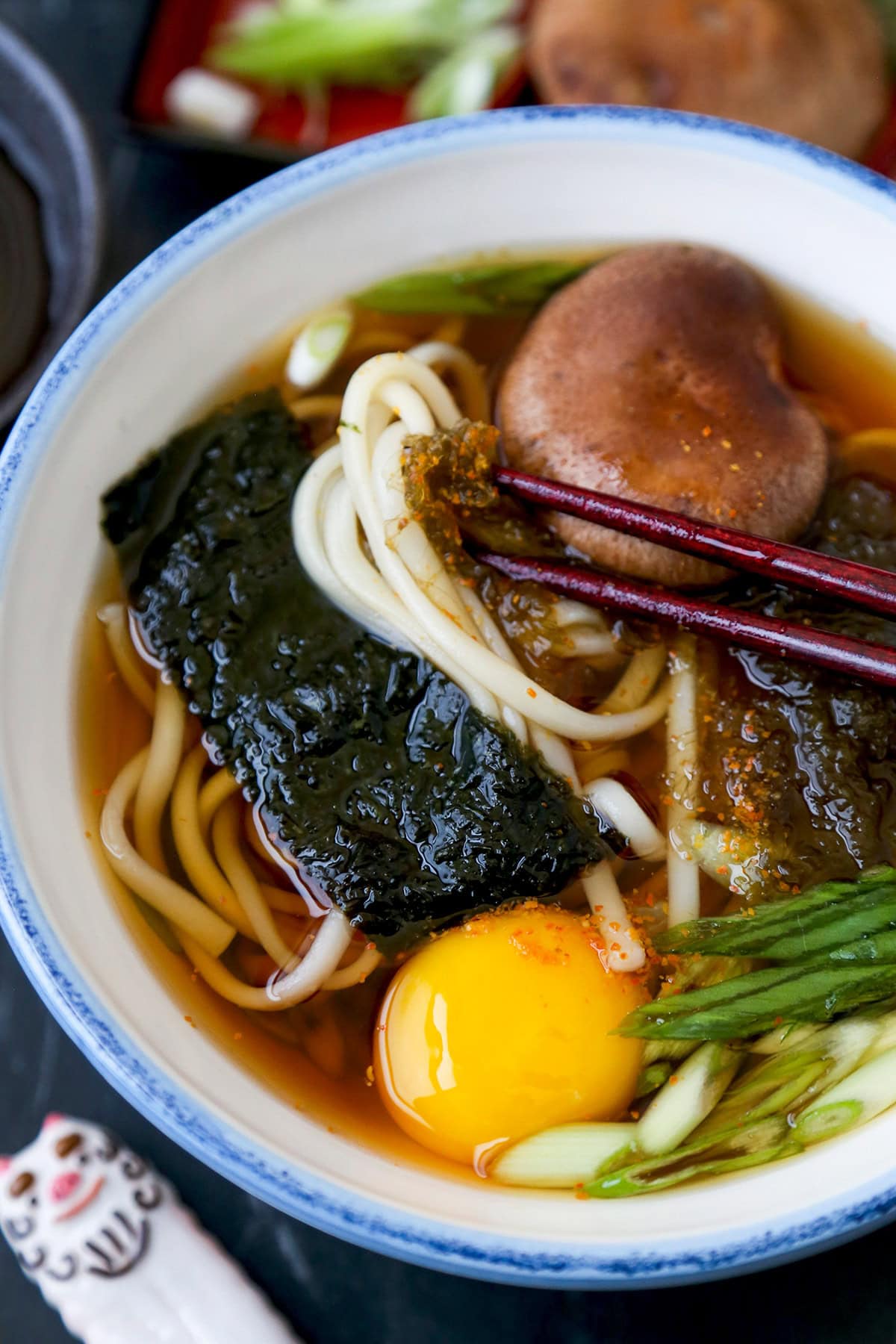
Why This Recipe Works
- Easy to make. There are only three steps to this recipe – make the broth, boil the noodles, and add the toppings.
- Affordable Japanese food. Making udon soup at home is very cheap compared to how much restaurants charge, and doesn’t taste that much different.
- Kid friendly. The savory, umami, and slightly sweet flavors of the broth, mixed with chewy udon noodles make this dish a favorite among kids in Japan.
Table of contents
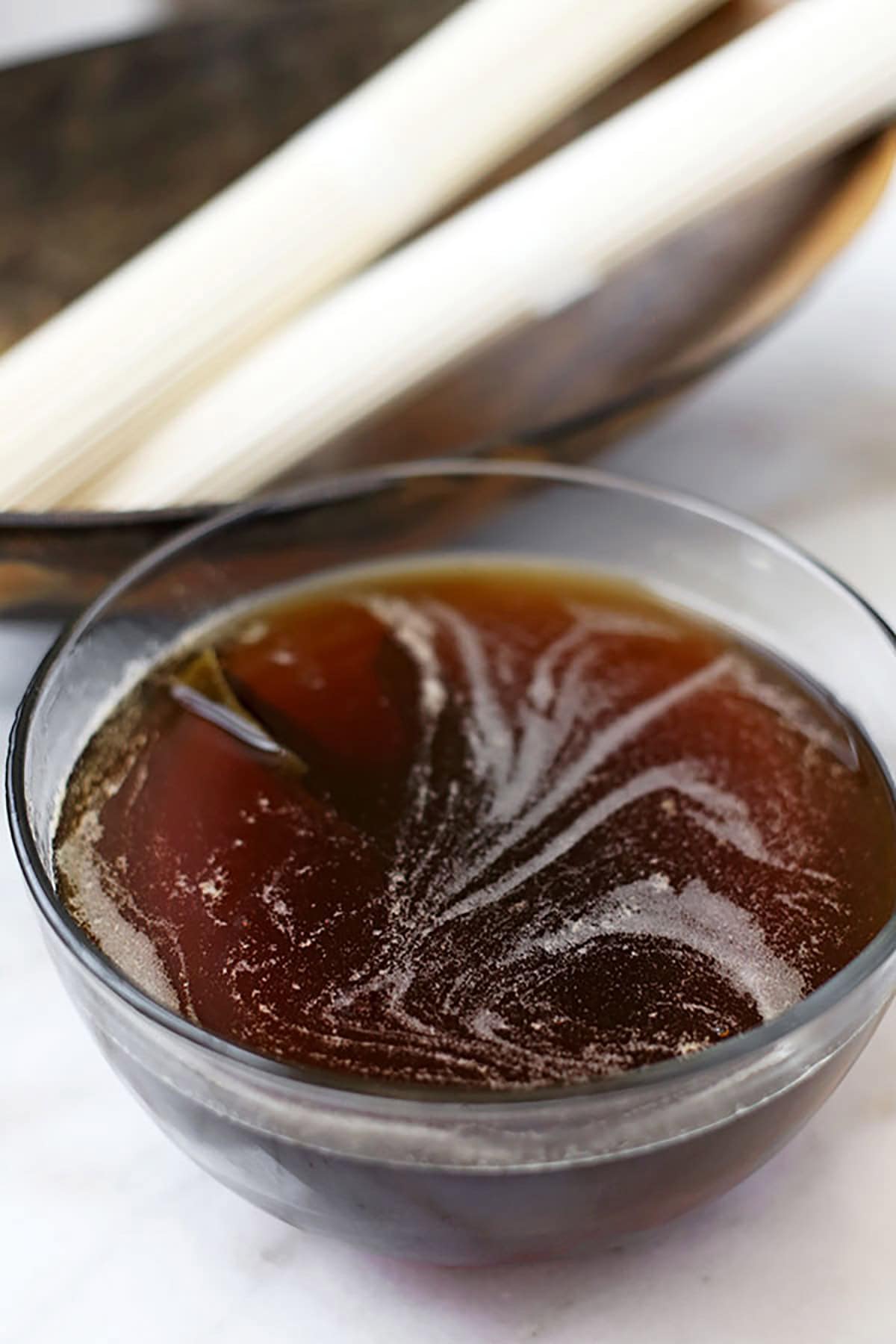
Best Type of Noodles to Use for This Soup
While dry udon noodles are great to eat cold, dipped in tsuyu broth, they are not the best option when it comes to soups. That’s because dry udon noodles tend to be thinner than fresh or frozen ones and because of that, don’t hold as well when served in a hot broth.
My personal favorite are sanuki udon noodles (さぬき), which hail from the Kagawa prefecture (香川県) in Japan. The noodles are square shaped, thick, and have a chewy texture that’s both firm and soft. They are the most popular choice in Japan to be served in soups, bukkake udon, (chilled with a dashi sauce and topped with various ingredients), or kamaage udon (served in a bowl of hot water and a side of hot dipping sauce). If you cannot find sanuki udon, fresh or frozen udon noodles are also good options.
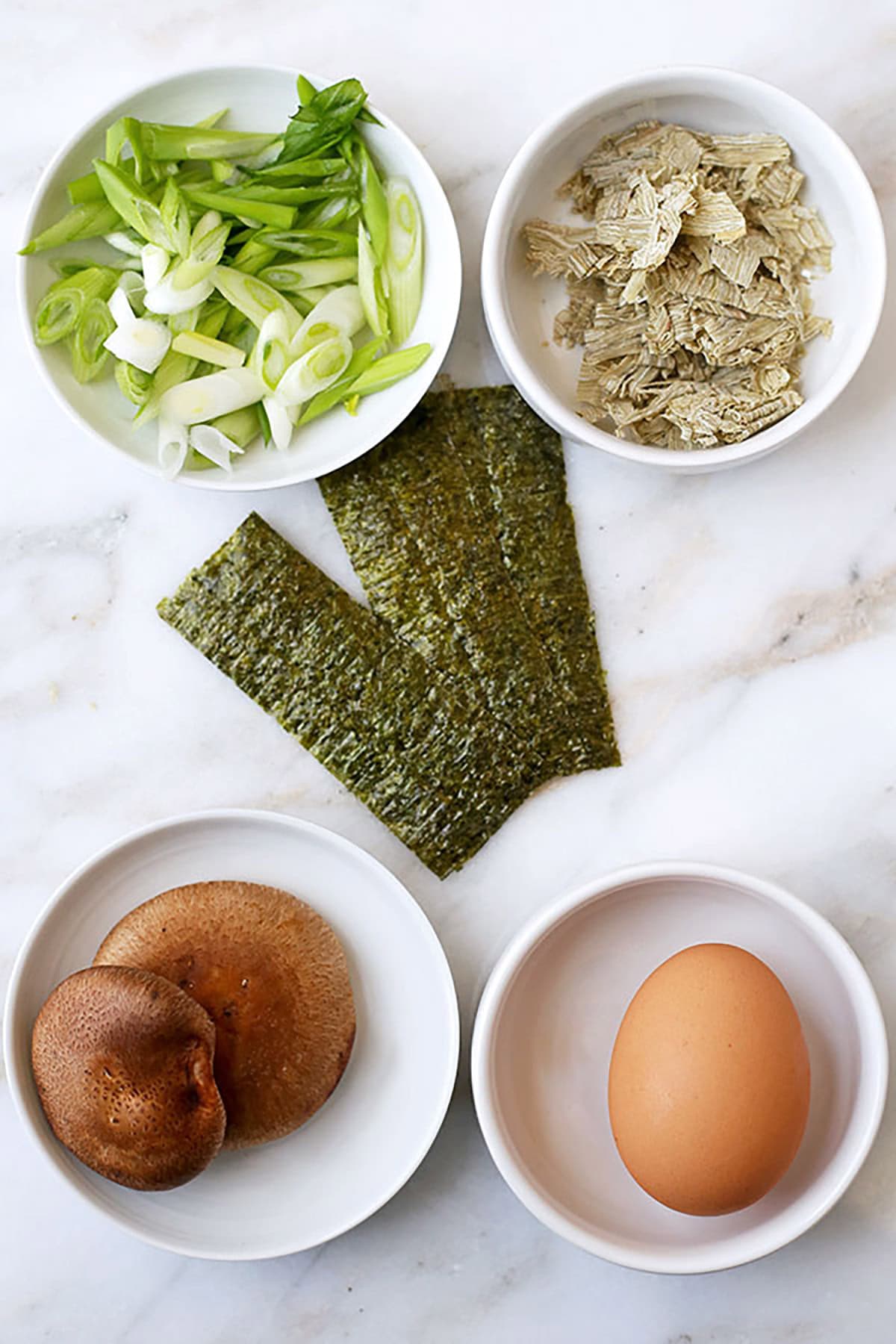
Ingredients
- Dashi: You can make dashi from scratch which is very easy (I have recipes for both fish based or vegan dashi), or you can buy dashi powder. If you are using it in powder form, make sure to pick a good one such as the Kayanoya brand, which has been around in Japan for over 100 years.
- Water: Udon broth is much milder in taste than a traditional ramen broth, which is why it needs to be diluted with water.
- Soy Sauce: Soy sauce is for umami and to infuse savory and salty flavors. I’m using 1 1/2 tablespoon but if you are watching your salt intake, you can start by using 1/2 tablespoon and go from there (do a taste test).
- Mirin: Mirin is soy sauce’s best friend! Its sweet and sake-like flavors balance the umami and saltiness of soy sauce to perfection.
- Kombu: You don’t need to use kombu if you are making a vegan broth. Kombu adds a slight mineral taste to the broth that is reminiscent of the ocean.
- Udon noodles: As previously mentioned, fresh or frozen sanuki noodles are the best choice for udon soup. The second option is regular fresh or frozen udon noodles. And lastly, dry udon noodles.
- Toppings: I like to add chopped scallions, a raw egg, shiitake mushrooms, tororo kombu, and nori to mine. But go ahead and use any toppings you like such as chopped spinach, fish cakes, fried tofu, or tempura flakes.
Variations
- Low Sodium: Use ½ tablespoon soy sauce instead of the recommend 1 ½ tablespoon. You can also use a less sodium soy sauce.
- Vegan: Make a vegan dashi from scratch using this recipe. Or you can use powdered kombu dashi.
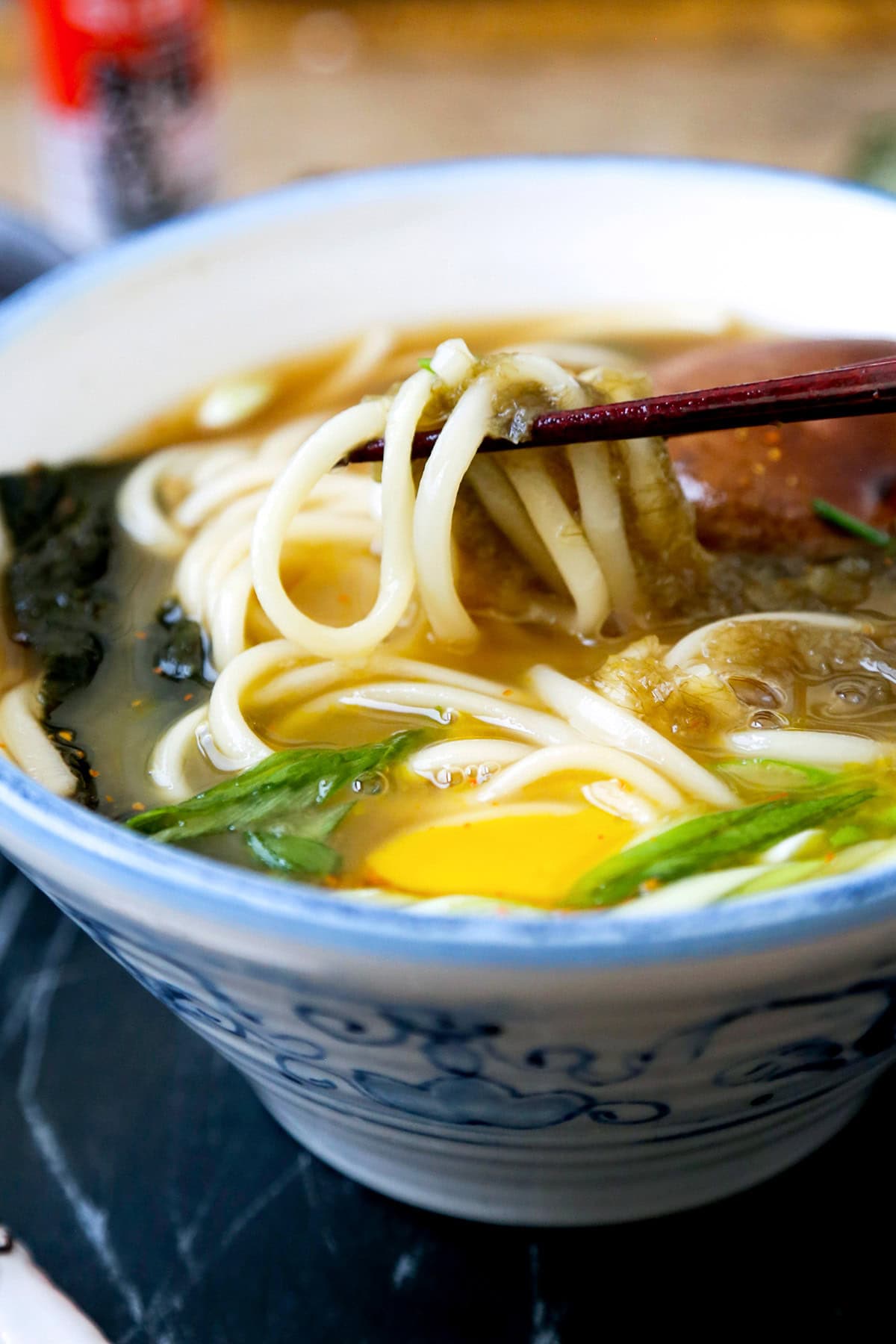
How To Make My Kake Udon Recipe
- Gather and prep all of your ingredients.
- Put all the ingredients for the broth in a pot, stir, and leave for 10 minutes. This is to let the kombu steep and release flavor.
- Turn the heat on and bring the broth to a boil. As soon as it boils, take the kombu out. Lower the heat to medium low, cover, and simmer for 5 minutes.
- Meanwhile fill another pot with water and bring it to boil. Add the udon noodles and follow the instructions on the package. Frozen or fresh udon noodles usually take 2 to 3 minutes to cook. Drain well.
- Grab two soup or ramen bowls and divide the broth and noodles. Use your favorite ingredients as toppings and serve immediately.
Cooking Tips
- Chopping the green onions on the bias makes them easier to grab with chopsticks.
- Only add the noodles to the broth right before serving the dish. This prevents them from soaking up too much broth and expanding.
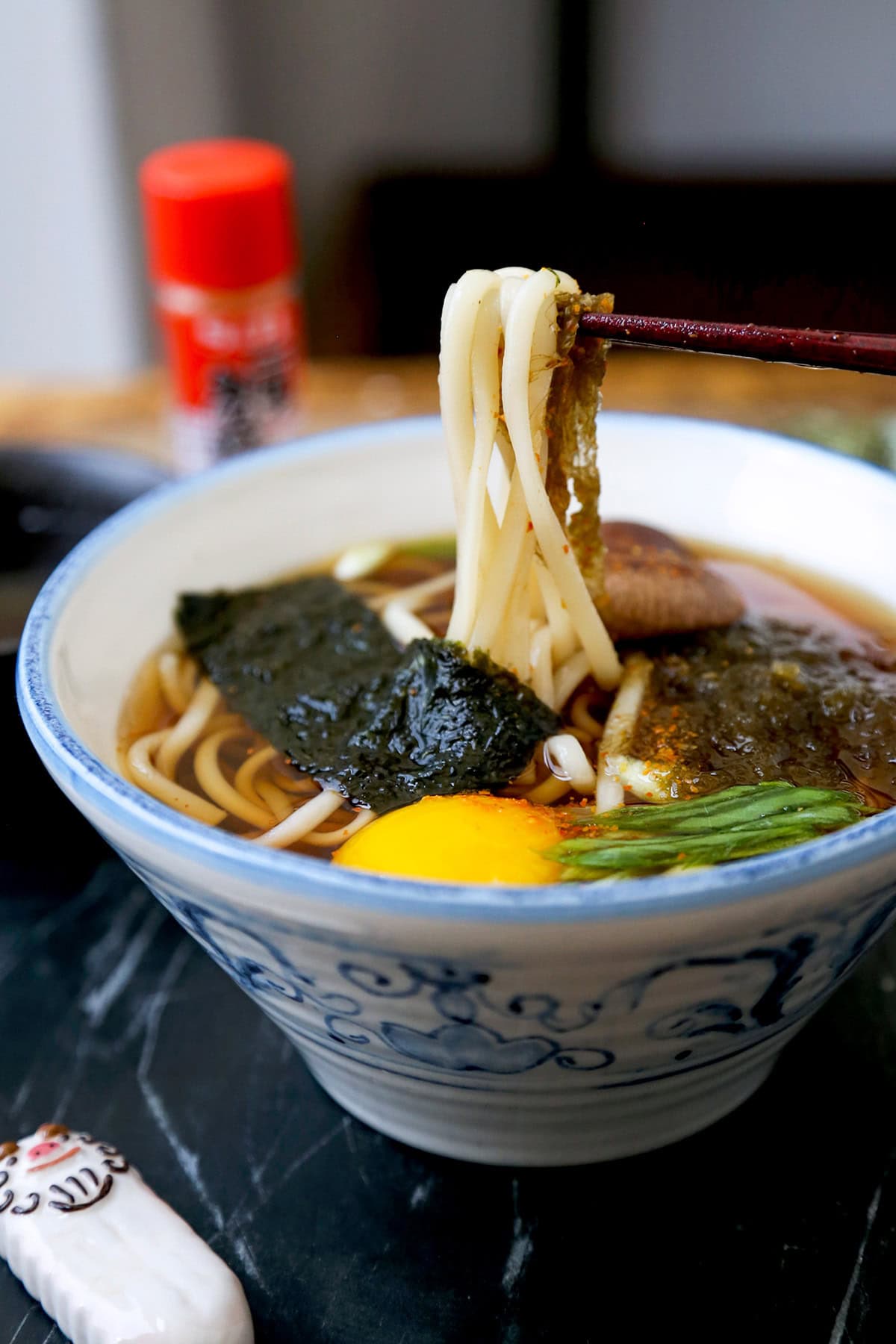
Storage
The dish itself cannot be saved as the cooked noodles will get mushy and expand to the point where it will absorb most of the broth.
But you can make the broth ahead of time and store it in the freezer of fridge. Save it in an airtight storage container and refrigerate for up to 2 weeks in the fridge, or 2 months in the freezer.
Frequently Asked Questions
No it is not. There is soy sauce sauce in the broth and the noodles are made of wheat flour, which contains gluten.
While both noodles are made with wheat flour – contrary to the belief that ramen noodles are the same as egg noodles (they usually do not contain any eggs), udon noodles are usually thicker and chewier. Also, while udon is most often served with a traditional tsuyu, soy sauce, or dashi based broth, ramen can be served with richer broths such as tonkotsu (milky pork based broth).
Udon soup is relatively healthy since it’s low in fat and calories. But the downside is it can be high in sodium. If you are watching your sodium intake, make sure to use a low sodium soy sauce when making the soup.
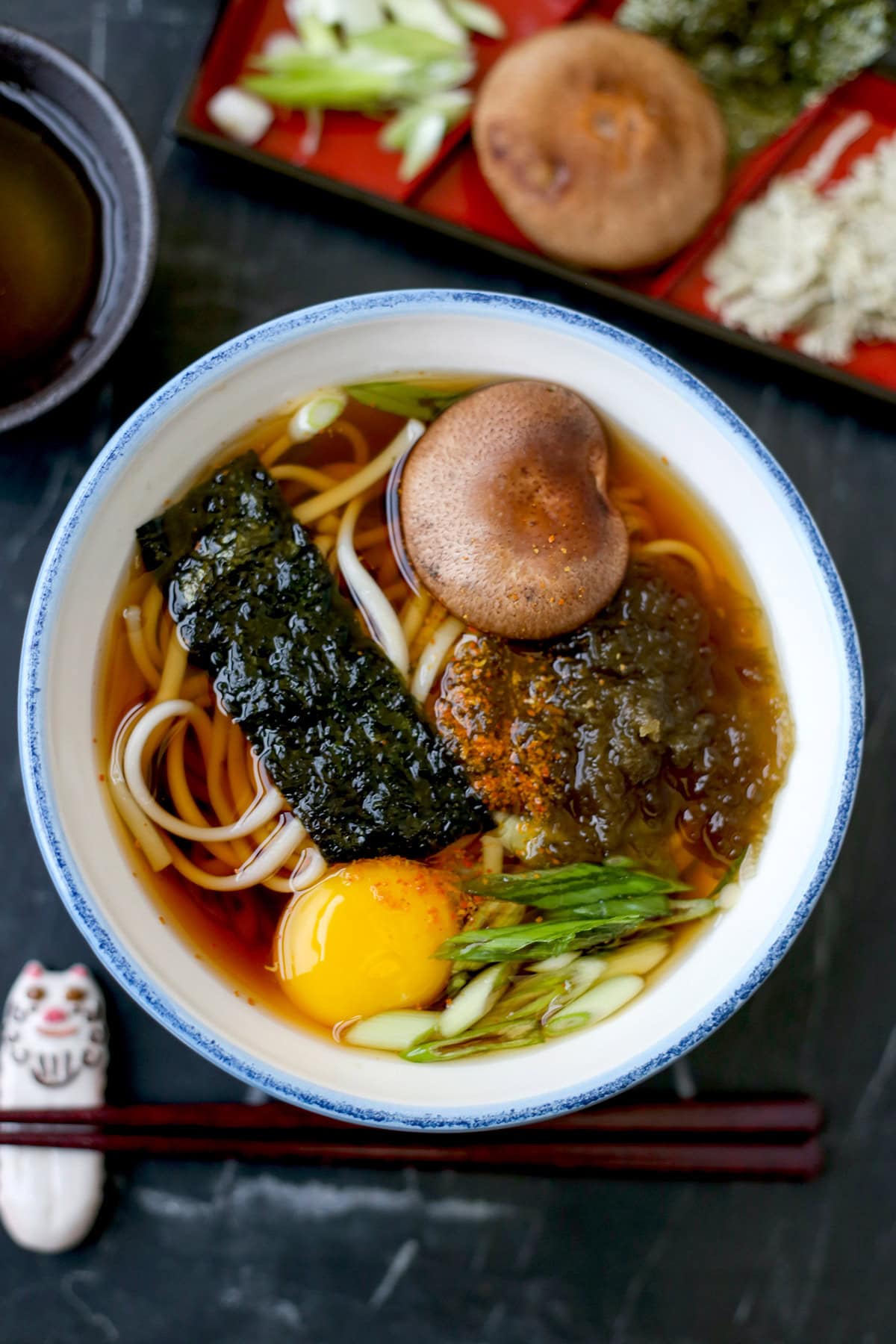
What To Serve With This Soup
Udon soup can be served for lunch or dinner as it is filling enough to be considered a main dish. In Japan, it will be accompanied with small sides such as edamame, hiyayakko (chilled tofu), or hijiki salad.
Other delicious sides that can be served are:
- Gomae (Japanese spinach salad)
- Kaisou salad (Japanese seaweed salad)
- Agedashi tofu (deep fried tofu with tsuyu broth)
- Nasu dengaku (broiled eggplant with miso glaze)
Have you made this wood ear mushroom salad recipe? Are there changes you made that you would like to share? Share your tips and recommendations in the comments section below!
Print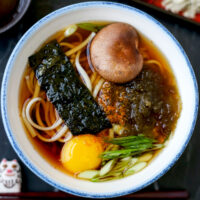
Easy Udon Soup (かけうどん)
- Prep Time: 5 minutes
- Cook Time: 10 minutes
- Total Time: 15 minutes
- Yield: 2 servings 1x
- Category: Soups
- Method: Boiling
- Cuisine: Japanese
- Diet: Vegetarian
Description
This is a basic udon soup recipe made with chewy noodles, a light and savory broth, and topped with various toppings.
Ingredients
- 8 ounces dry udon noodles or 2 packets of fresh udon noodles
Broth
- 1 cup dashi (click here if for homemade dashi (vegan option also available), or use 1 teaspoon dashi powder mixed with 1 cup water
- 1 cup water
- 1 1/2 tablespoon soy sauce
- 3 tablespoons mirin
- 3-inch piece kombu (dried kelp)
Toppings
- 3 stalks green onions, chopped
- 2 shiitake mushrooms
- 2 eggs
- 2 dry nori sheets
- tororo kombu (optional)
Instructions
- Put all the ingredients for the broth in a pot and leave for 10 minutes. Bring to a boil and remove the kelp. Lower the heat, cover and simmer on low for 5 minutes. If you are using shiitake mushrooms for topping, add them to the broth and simmer together.
- Bring a pot of water to boil and add your udon noodles. Cook noodles according to the directions on the package. Save some of the water (about a cup), drain and set aside.
- Divide the noodles and broth between two bowls and add topping of your choice. Serve hot.
- Add a little of the hot udon water that you saved to dilute the broth if it’s too strong.
Notes
Leftover broth:
- You can refrigerate the broth in an airtight storage container. It will keep for up to 1 month.
- Or you can freeze the broth in an airtight storage container (let it cool to room temperature first) and it will last for up to 3 months.
Nutrition
- Serving Size: 1 bowl
- Calories: 497
- Sugar: 17.4g
- Sodium: 1683.7mg
- Fat: 6.7g
- Saturated Fat: 1.9g
- Unsaturated Fat: 1.2g
- Trans Fat: 0g
- Carbohydrates: 85.8g
- Fiber: 1.5g
- Protein: 13.3g
- Cholesterol: 192.8mg
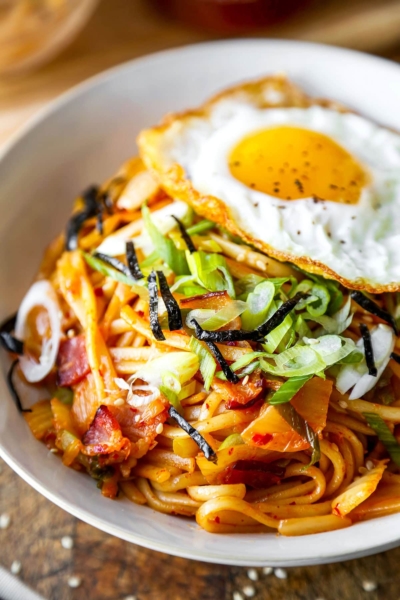
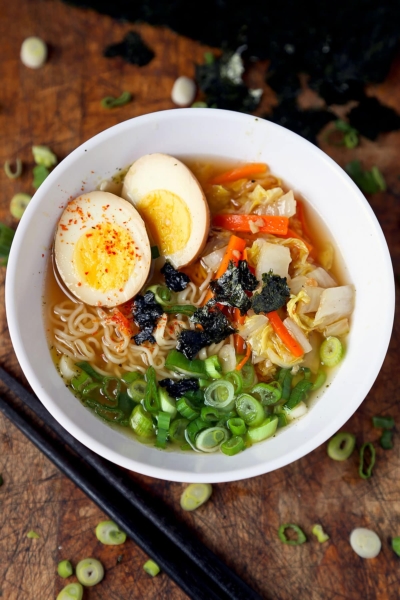
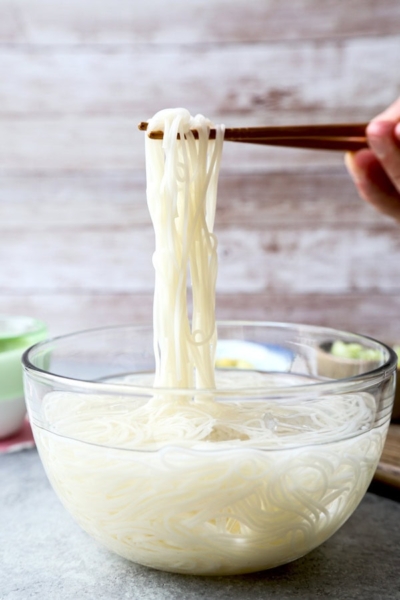
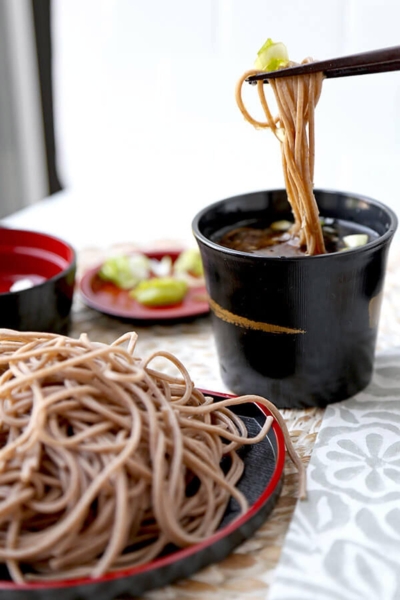















Questions and Reviews
I love,love your recipes.Somehow I lost the recipes you where mentionnig that now you leave in Japan (lucky Women)…….I do not know if it was the one of the 10 or 11 nov. But I would love to have it.Of course if you can. Thank you in advance,an old fan.
This broth tasted authentic. Such a simple and yet flavorful recipe. Thank you!
I have been wanting to try more Japanese cuisine type dishes and stumbled up this recipe/ website and I just made the udon noodles the Japanese fried rice and miso soup and all the recipes especially this one was terrific it tastes exactly like the Japanese’s restaurants i go to. Thank you!
Thank you Genevieve! It’s one of my favorite lunches to make 🙂
This has become a favourite in my house! My two daughters (ages 11 and 14) both love to cook, and make this recipe at least once or twice a month!! They aren’t into the raw egg though, so they make soft boiled eggs instead.
Hi !
I’m new to Japanese cuisine and you totally sold me on this recipe!
I’m going to try it out tomorrow but was wondering do you cook the egg?
Thanks! Love your website
Hi Danica, I don’t cook the egg because the slimy texture doesn’t bother me. However my husband prefers a poached egg which is very easy to make with and egg cooker 🙂
What are tempura bits?
Hi Janyne, tempura bits are fried bits of dough sold in small packages. You can see an example here: https://www.amazon.com/Yamahide-Tempura-Bits-50g-packs/dp/B01FTG1CTW They are crunchy and are served as toppings to sushi, in soups, etc..